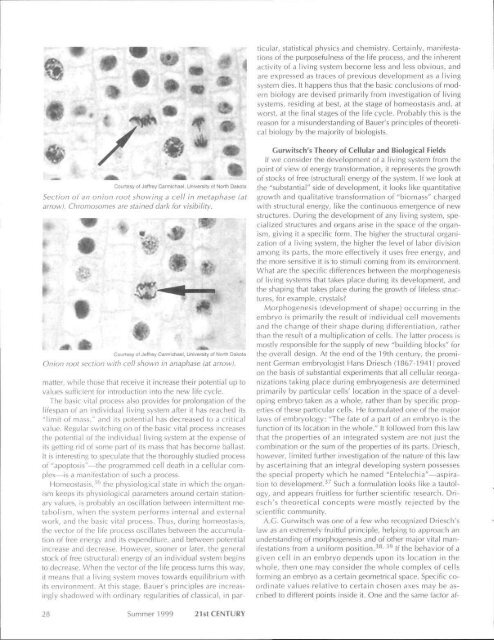Back to the Moon with Nuclear Rockets
Back to the Moon with Nuclear Rockets
Back to the Moon with Nuclear Rockets
- No tags were found...
Create successful ePaper yourself
Turn your PDF publications into a flip-book with our unique Google optimized e-Paper software.
matter, while those that receive it increase <strong>the</strong>ir potential up <strong>to</strong>values sufficient for introduction in<strong>to</strong> <strong>the</strong> new life cycle.The basic vital process also provides for prolongation of <strong>the</strong>lifespan of an individual living system after it has reached its"limit of mass," and its potential has decreased <strong>to</strong> a criticalvalue. Regular switching on of <strong>the</strong> basic vital process increases<strong>the</strong> potential of <strong>the</strong> individual living system at <strong>the</strong> expense ofits getting rid of some part of its mass that has become ballast.It is interesting <strong>to</strong> speculate that <strong>the</strong> thoroughly studied processof "apop<strong>to</strong>sis"—<strong>the</strong> programmed cell death in a cellular complex—isa manifestation of such a process.Homeostasis, 36 <strong>the</strong> physiological state in which <strong>the</strong> organismkeeps its physiological parameters around certain stationaryvalues, is probably an oscillation between intermittent metabolism,when <strong>the</strong> system performs internal and externalwork, and <strong>the</strong> basic vital process. Thus, during homeostasis,<strong>the</strong> vec<strong>to</strong>r of <strong>the</strong> life process oscillates between <strong>the</strong> accumulationof free energy and its expenditure, and between potentialincrease and decrease. However, sooner or later, <strong>the</strong> generals<strong>to</strong>ck of free (structural) energy of an individual system begins<strong>to</strong> decrease. When <strong>the</strong> vec<strong>to</strong>r of <strong>the</strong> life process turns this way,it means that a living system moves <strong>to</strong>wards equilibrium <strong>with</strong>its environment. At this stage, Bauer's principles are increasinglyshadowed <strong>with</strong> ordinary regularities of classical, in particular,statistical physics and chemistry. Certainly, manifestationsof <strong>the</strong> purposefulness of <strong>the</strong> life process, and <strong>the</strong> inherentactivity of a living system become less and less obvious, andare expressed as traces of previous development as a livingsystem dies. It happens thus that <strong>the</strong> basic conclusions of modernbiology are devised primarily from investigation of livingsystems, residing at best, at <strong>the</strong> stage of homeostasis and, atworst, at <strong>the</strong> final stages of <strong>the</strong> life cycle. Probably this is <strong>the</strong>reason for a misunderstanding of Bauer's principles of <strong>the</strong>oreticalbiology by <strong>the</strong> majority of biologists.Courtesy of Jeffrey Carmichael, University of North DakotaSection of an onion root showing a cell in metaphase (atarrow). Chromosomes are stained dark for visibility.Onion root section <strong>with</strong> cell shown in anaphase (at arrow).Gurwitsch's Theory of Cellular and Biological FieldsIf we consider <strong>the</strong> development of a living system from <strong>the</strong>point of view of energy transformation, it represents <strong>the</strong> growthof s<strong>to</strong>cks of free (structural) energy of <strong>the</strong> system. If we look at<strong>the</strong> "substantial" side of development, it looks like quantitativegrowth and qualitative transformation of "biomass" charged<strong>with</strong> structural energy, like <strong>the</strong> continuous emergence of newstructures. During <strong>the</strong> development of any living system, specializedstructures and organs arise in <strong>the</strong> space of <strong>the</strong> organism,giving it a specific form. The higher <strong>the</strong> structural organizationof a living system, <strong>the</strong> higher <strong>the</strong> level of labor divisionamong its parts, <strong>the</strong> more effectively it uses free energy, and<strong>the</strong> more sensitive it is <strong>to</strong> stimuli coming from its environment.What are <strong>the</strong> specific differences between <strong>the</strong> morphogenesisof living systems that takes place during its development, and<strong>the</strong> shaping that takes place during <strong>the</strong> growth of lifeless structures,for example, crystals?Morphogenesis (development of shape) occurring in <strong>the</strong>embryo is primarily <strong>the</strong> result of individual cell movementsand <strong>the</strong> change of <strong>the</strong>ir shape during differentiation, ra<strong>the</strong>rthan <strong>the</strong> result of a multiplication of cells. The latter process ismostly responsible for <strong>the</strong> supply of new "building blocks" for<strong>the</strong> overall design. At <strong>the</strong> end of <strong>the</strong> 1 9th century, <strong>the</strong> prominentGerman embryologist Hans Driesch (1867-1941) provedon <strong>the</strong> basis of substantial experiments that all cellular reorganizationstaking place during embryogenesis are determinedprimarily by particular cells' location in <strong>the</strong> space of a developingembryo taken as a whole, ra<strong>the</strong>r than by specific propertiesof <strong>the</strong>se particular cells. He formulated one of <strong>the</strong> majorlaws of embryology: "The fate of a part of an embryo is <strong>the</strong>function of its location in <strong>the</strong> whole." It followed from this lawthat <strong>the</strong> properties of an integrated system are not just <strong>the</strong>combination or <strong>the</strong> sum of <strong>the</strong> properties of its parts. Driesch,however, limited fur<strong>the</strong>r investigation of <strong>the</strong> nature of this lawby ascertaining that an integral developing system possesses<strong>the</strong> special property which he named "Entelechia"—aspiration<strong>to</strong> development. 37 Such a formulation looks like a tau<strong>to</strong>logy,and appears fruitless for fur<strong>the</strong>r scientific research. Driesch's<strong>the</strong>oretical concepts were mostly rejected by <strong>the</strong>scientific community.A.G. Gurwitsch was one of a few who recognized Driesch'slaw as an extremely fruitful principle, helping <strong>to</strong> approach anunderstanding of morphogenesis and of o<strong>the</strong>r major vital manifestationsfrom a uniform position. If <strong>the</strong> behavior of a38, 39given cell in an embryo depends upon its location in <strong>the</strong>whole, <strong>the</strong>n one may consider <strong>the</strong> whole complex of cellsforming an embryo as a certain geometrical space. Specific coordinatevalues relative <strong>to</strong> certain chosen axes may be ascribed<strong>to</strong> different points inside it. One and <strong>the</strong> same fac<strong>to</strong>r af-28 Summer 1999 21st CENTURY
















